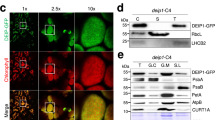Abstract
FOLDING of the major cytoskeletal components in the cytosol of mammalian cells is mediated by interactions with t-complex polypeptide-1 (TCP1) molecular chaperones1–6, a situation analogous to the chaperonin 60-aided folding of polypeptides in bacteria7,8, chloroplasts9,10 and mitochondria11,13. We have purified a TCP1-related molecular chaperone from etiolated oat seedlings that has a unique structure. Although immunologically related to TCP1, and having amino-acid sequence similarity, its quaternary structure is different from animal TCP1 proteins5,6–14. Electron microscopy and image analysis reveals that the chaperone has two stacked rings of six subunits each, and is distinct in size and configuration. The chaperone copurifies with the soluble cytosolic photoreceptor phytochrome15, and can stimulate refolding of denatured phytochrome to a photoactive form in the presence of Mg–ATP. We propose that this protein is the cytosolic chaperone involved in phytochrome biogenesis in plant cells.
Similar content being viewed by others
References
Ellis, R.J. Science 250, 954–959 (1990).
Gupta, R.S. Biochem. Int. 4, 833 (1990).
Willison, K. et al. Cell 57, 631–632 (1989).
Yaffe, M.B. et al. Nature 358, 245–248 (1992).
Lewis, V.A., Hynes, G.M., Zheng, D., Saibil, H. & Willison, K. Nature 358, 249–252 (1992).
Frydman, J. et al. EMBO J. 11, 4767–4778 (1992).
Hendrix, R.W. J. molec. Biol. 129, 375–392 (1979).
Gatenby, A.A. & Ellis, R.J. Rev. Cell Biol. 6, 125–149 (1990).
Hemmingsen, S.M. et al. Nature 333, 330–334 (1988).
Hemmingsen, S.M. & Ellis, R.J. Pl. Physiol. 80, 269–276 (1986).
McMullin, T. & Hallberg, R.L. Molec. cell. Biol. 8, 371–380 (1988).
Hallberg, R.L. Semin. Cell Biol. 1, 37–45 (1990).
Jindal, S., Dudani, A.K., Singh, B., Harley, C.B. & Gupta, R.S. Molec. cell. Biol. 9, 2279–2283 (1989).
North, G. Nature 354, 434–435 (1991).
Furuya, M. Adv. Biophys. 25, 133–167 (1989).
Gilmartin, P.M., Sarokin, L., Memelink, J. & Chua, N. -H. Pl. Cell 2, 369–378 (1990).
Mori, M. et al. Gene 122, 381–382 (1992).
Kubota, H. et al. Gene 120, 207–215 (1992).
Ellis, R.J. & van der Vies, S.M. A. Rev. Biochem. 60, 321–347 (1991).
Trent, J.D., Nimmersgem, E., Wall, J.S., Harti, F.-U. & Horwich, A.L. Nature 354, 490–493 (1991).
Viitanen, P.V. et al. Biochemistry 29, 5665–5671 (1990).
Phipps, B.M. et al. Nature 361, 475–477 (1993).
Lill, R., Dowhan, W. & Wickner, W. Cell 60, 271–280 (1990).
Rüdiger, W., Thümmler, F., Cmiel, E. & Schneider, S. Proc. natn. Acad. Sci. U.S.A. 80, 6244–6248 (1983).
Grimm, R., Donaldson, G.K., van der Vies, S.M., Schäfer, E. & Gatenby, A.A. J. biol. Chem. 268, 5220–5226 (1993).
Grimm, R. & Rüdiger, W.Z. Naturforschung 41c, 988–992 (1986).
Laemmli, U.K. Nature 227, 680–685 (1970).
Jackson, J.F. in Modern Methods of Plant Analysis, Vol1, Cell Components (eds Linskens, H.F. & Jackson, J. F.) 301 (Springer, Berlin, 1985).
Pilwat, G., Hampp, R. & Zimmermann, U. Planta 147, 396–404 (1980).
Görg, A., Postel, W. & Günther, S. Electrophoresis 9, 531–546 (1988).
Eckerskorn, C., Mewes, W., Goretzki, H. & Lottspeich, F. Eur. J. Biochem. 176, 509–519 (1988).
Markham, R., Frey, S. & Hills, G.J. Virology 20, 88–102 (1963).
Gross, J., Seyfried, M., Fukshansky, L. & Schäfer, E. in Techniques in Morphogenesis (eds Smith, H. & Holmes, M.G.) 131–158 (Academic, London, 1984).
Author information
Authors and Affiliations
Rights and permissions
About this article
Cite this article
Mummert, E., Grimm, R., Speth, V. et al. ATCPl-related molecular chaperone from plants refolds phytochrome to its photoreversible form. Nature 363, 644–648 (1993). https://doi.org/10.1038/363644a0
Received:
Accepted:
Issue Date:
DOI: https://doi.org/10.1038/363644a0
- Springer Nature Limited
This article is cited by
-
Molecular chaperones and protein folding in plants
Plant Molecular Biology (1996)
-
Purification and characterization of a 60-kDa protein from oat, formerly known as a TCP1-related chaperone
Journal of Protein Chemistry (1995)
-
Initial events in phytochrome signalling: still in the dark
Plant Molecular Biology (1994)





